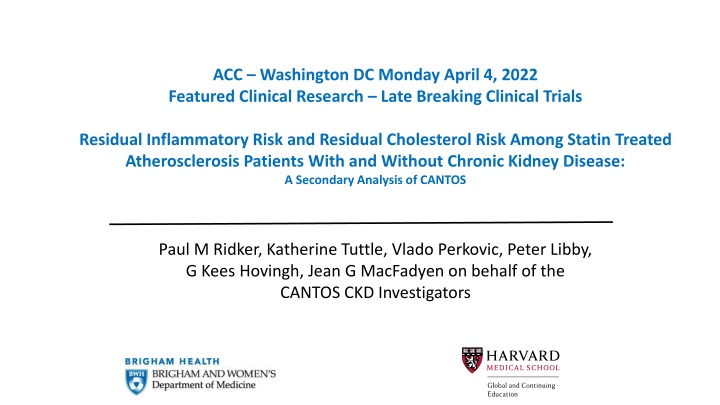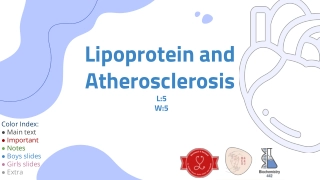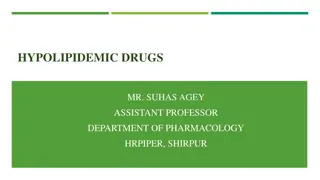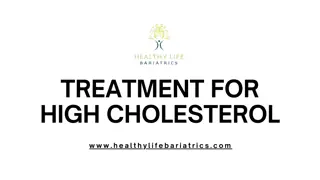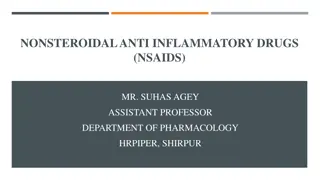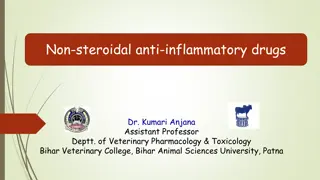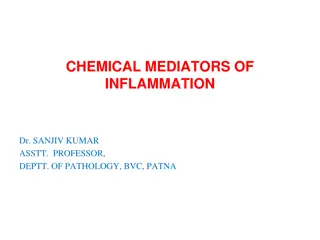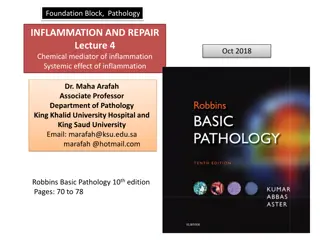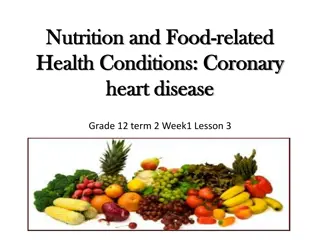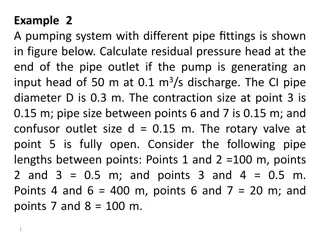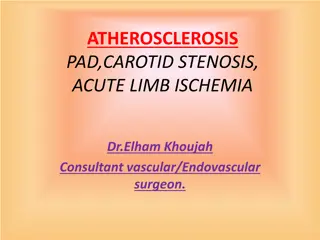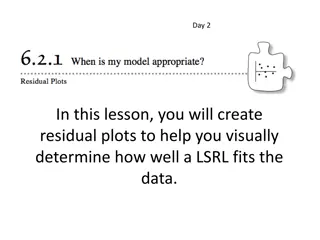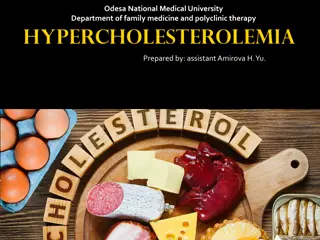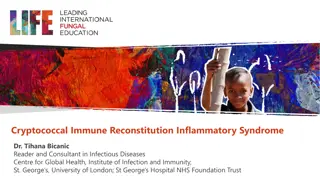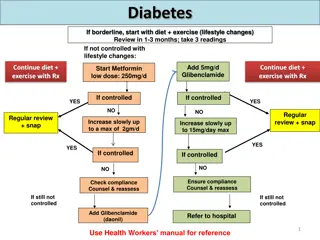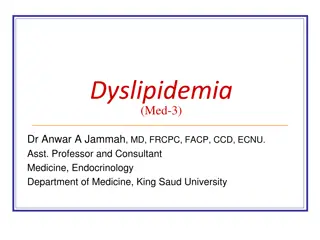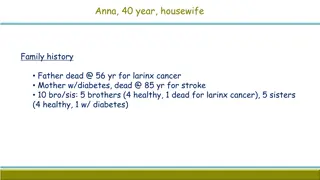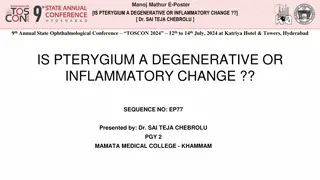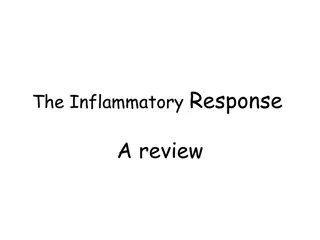Residual Inflammatory and Cholesterol Risks in Atherosclerosis Patients
In a secondary analysis of the CANTOS study, researchers evaluated the impact of residual inflammatory risk and residual cholesterol risk in a large cohort of atherosclerosis patients already receiving lipid-lowering therapy. Results showed the relative contributions of inflammation and cholesterol in patients with and without chronic kidney disease. Canakinumab, an IL-1 neutralizing antibody, demonstrated a reduction in cardiovascular events. The CANTOS CKD substudy further stratified cardiovascular outcomes based on renal function. Overall, the study highlights the importance of targeting residual inflammatory and cholesterol risks in atherosclerosis management.
Download Presentation

Please find below an Image/Link to download the presentation.
The content on the website is provided AS IS for your information and personal use only. It may not be sold, licensed, or shared on other websites without obtaining consent from the author.If you encounter any issues during the download, it is possible that the publisher has removed the file from their server.
You are allowed to download the files provided on this website for personal or commercial use, subject to the condition that they are used lawfully. All files are the property of their respective owners.
The content on the website is provided AS IS for your information and personal use only. It may not be sold, licensed, or shared on other websites without obtaining consent from the author.
E N D
Presentation Transcript
ACC Washington DC Monday April 4, 2022 Featured Clinical Research Late Breaking Clinical Trials Residual Inflammatory Risk and Residual Cholesterol Risk Among Statin Treated Atherosclerosis Patients With and Without Chronic Kidney Disease: A Secondary Analysis of CANTOS Paul M Ridker, Katherine Tuttle, Vlado Perkovic, Peter Libby, G Kees Hovingh, Jean G MacFadyen on behalf of the CANTOS CKD Investigators
Residual Inflammatory Risk and Residual Cholesterol Risk in the Contemporary Care of Atherosclerosis Hyperlipidemia and inflammation jointly contribute to atherosclerotic disease and both have proven to be effective targets for pharmacologic and non- pharmacologic interventions. Yet, the relative contributions of these processes may differ in important ways in various patient groups, such as those with impaired kidney function, a group with very high risk for atherosclerotic events and substantial unmet clinical need. We therefore sought to assess the relative impact of residual inflammatory risk and residual cholesterol risk in a contemporary large-scale cohort of atherosclerosis patients already treated with guideline lipid lowering therapy. Ridker PM. Eur Heart J 2016;37:1720-22
Canakinumab, a Human Monoclonal Antibody Neutralizing IL-1 MACE+ (150, 300 mg doses vs placebo) HR 0.83, 95%CI 0.74-0.92, P=0.0006 Ridker et al N Engl J Med. 2017;377:1119-31
CANTOS CKD Substudy : Primary Cardiovascular Results Stratified by Baseline eGFR eGFR > 60 mL/min/1.73m2 eGFR < 60 mL/min/1.73m2 Confirmed MACE+Urgent Revascularization Among Subjects whose baseline eGFR >=60 Confirmed MACE+Urgent Revascularization Among Subjects whose baseline eGFR <60 0.4 0.4 HR (95% CI) P 1.0 (ref) (ref) 0.86 (0.77,0.97) 0.012 _______________________________________________ Placebo Active Canakinumab HR (95% CI) P 1.0 (ref) (ref) 0.82 (0.68,1.00) 0.054 _______________________________________________ Placebo Active Canakinumab HR 0.82 95%CI 0.68-1.00 P = 0.05 HR 0.86 95%CI 0.77-0.97 P = 0.01 0.3 0.3 Cumulative Incidence Cumulative Incidence 0.2 0.2 0.1 0.1 0.0 0.0 0 1 2 3 4 5 0 1 2 3 4 5 Follow-up (years) Years Follow-up (years) Years No. at risk: Placebo Canakinumab No. at risk: Placebo Canakinumab 626 1249 561 1139 499 1047 423 894 182 410 27 58 2717 5467 2546 5177 2422 4940 2155 4410 1056 2155 179 382 Normal Renal Function (N = 7,949) Moderate CKD (N = 1,192) Ridker et al JACC 2018;71:2405-14
Residual Inflammatory Risk and Residual Cholesterol Risk Among Statin Treated Atherosclerosis Patients With and Without Chronic Kidney Disease Methods: Among 9,151 stable statin treated post-myocardial infarction patients being randomized into CANTOS, we compared the relative contributions of residual cholesterol risk and residual inflammatory risk as determinants of recurrent major adverse cardiovascular events (MACE), CV death, and total mortality, stratified by baseline estimated glomerular filtration rate (eGFR) above or below 60 mL/min/1.73m2 using the race agnostic CKD-EPI 2021 formula. Biomarkers: Analyses of inflammation focused on high-sensitivity C-reactive protein (hsCRP) and interleukin-6 (IL-6) while lipid analyses focused on low-density lipoprotein cholesterol (LDLC) and non-high- density lipoprotein cholesterol (non-HDLC). All measures performed in a core laboratory. Outcomes and Analysis: Participants were followed for a period of up to 5 years. Primary analyses focused on major adverse cardiovascular events, CV mortality and all-cause mortality both in univariate and multivariate analyses, as well as addressing for joint effects across stratum of eGFR. All analyses additionally controlled for randomized treatment assignment.
Results I: Predictive utility of hsCRP, IL-6, LDLC, and non-HDLC for recurrent major adverse cardiovascular events (MACE) among participants with preserved kidney function (eGFR >60 ml/min/1.73m2) (N = 7,949) 3 3 P-trend < 0.001 P-trend < 0.001 P-trend < 0.001 P-trend < 0.001 Hazard Ratio Hazard Ratio 2 2 1 1 0 0 Quartile 1 Quartile 2 Quartile 3 Quartile 4 Quartile 1 Quartile 2 Quartile 3 Quartile 4 hsCRP IL-6 LDLC Non-HDLC MACE Preserved Kidney Function
Results II: Predictive utility of hsCRP, IL-6, LDLC, and non-HDLC for recurrent major adverse cardiovascular events (MACE) among participants with impaired kidney function (eGFR <60 ml/min/1.73m2) (N = 1,192) 3 3 P-trend = 0.01 P-trend = 0.02 P-trend = 0.72 P-trend = 0.96 Hazard Ratio Hazard Ratio 2 2 1 1 0 0 Quartile 1 Quartile 2 Quartile 3 Quartile 4 Quartile 1 Quartile 2 Quartile 3 Quartile 4 hsCRP IL-6 LDLC Non-HDLC MACE Impaired Kidney Function
Results III. Joint effects of hsCRP and LDLC on predicting cardiovascular mortality among those with and without chronic kidney disease. hsCRP and eGFR LDL-C and eGFR Cardiovascular Mortality
Results IV. Joint effects of hsCRP (left) and LDLC (right) on predicting all-cause mortality among those with and without chronic kidney disease. hsCRP and eGFR LDL-C and eGFR All-Cause Mortality
Residual Inflammatory Risk and Residual Cholesterol Risk Among Statin Treated Atherosclerosis Patients With and Without Chronic Kidney Disease Conclusions: 1. Among atherosclerosis patients with impaired kidney function already treated with statin therapy, residual inflammatory risk plays a substantial role in determining the risk of recurrent cardiovascular events. 2. These data have implications for risk stratification of individuals with chronic kidney disease and for the development of novel agents that target inflammatory processes in this high-risk group of patients. 3. These data provide additional strong rationale for the ZEUS randomized trial of ziltivekimab, a novel IL-6 ligand monoclonal antibody being tested to lower CV event rates in the setting of stage 3 and 4 chronic kidney disease.
Ziltivekimab Cardiovascular Outcomes Study (ZEUS) IL-6 inhibition with ziltivekimab 15mg SC monthly + usual care Major Adverse CV Events 6200 patients ASCVD CKD stage 3 4 hsCRP >2mg/L Renal Disease Progression Matching placebo injection SC monthly + usual care Ziltivekimab : Narrow spectrum fully human monoclonal antibody targeting the IL-6 ligand that is being developed specifically for atherosclerosis. RESCUE Trial : ziltivekimab 15 mg SC monthly markedly lowered hsCRP, fibrinogen, sPLA2, and Lp(a) without adverse lipid effects Ridker PM et al for the RESCUE Investigators. Lancet 2021;397:2060-2069 Ridker PM, Rane M. Interleukin-6 Signaling and Anti-Interleukin-6 Therapeutics in Cardiovascular Disease Circulation Research 2021;128:1728-1746.
